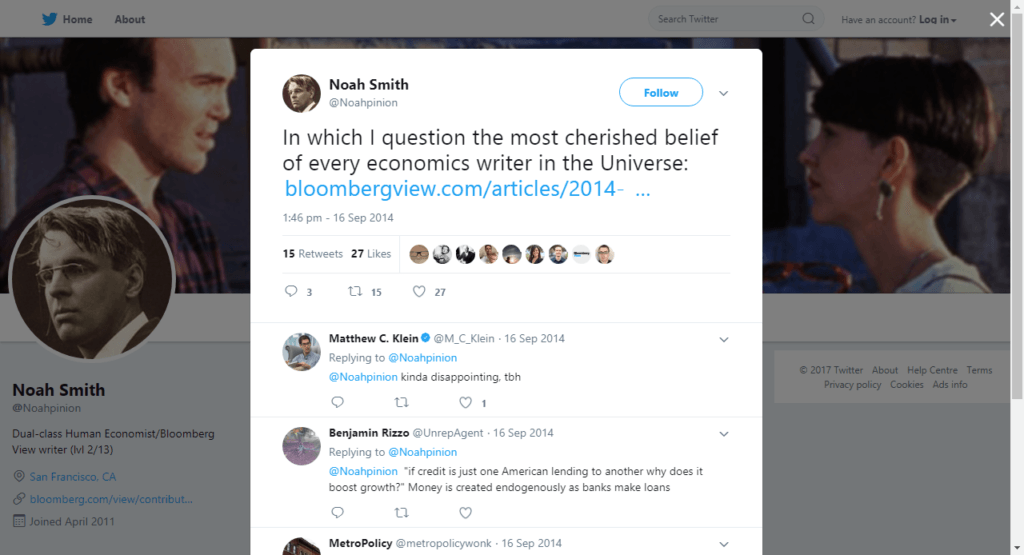In a new column for Bloomberg, Noah Smith questions the intuition that credit fuels economic growth.
click to view on Twitter
He says:
It seems like the only people who don’t instinctively believe in credit-fueled growth are academic economists.
The academics have good reason for being skeptical.
His reason (in short) is the following:
It’s pretty obvious how credit drives my personal household consumption. If I borrow, I can get a nice big TV and a new car, but eventually I’ll have to skimp to pay it back. In a way, the consumption-fueled borrowing binge is an illusion of wealth — after all, borrowing doesn’t increase my salary. Pleasure today means pain tomorrow.
Notice how Smith’s argument uses a lot of national accounting and flow of funds concepts: consumption, borrowing, wealth, repayment (of loans) and so on. The interesting thing is that one can use the system of national accounts and flow of funds to create models which show precisely the opposite of what Smith is saying. The best place obviously to look out for is the book Monetary Economics: An Integrated Approach to Credit, Money, Income, Production and Wealth by Wynne Godley and Marc Lavoie which has models called stock-flow consistent models or SFC models. It is however difficult to write down a simple SFC model in a blog post, so I will try to highlight how it works in words but refer the reader to these models.
Here’s how in a simple model:
- Consumers decide to borrow more and banks respond by granting them loans.
- Consumers spend the funds received on consumption goods.
- Since loans make deposits, it’s not as if someone forgoes consumption to lend as neoclassical textbooks say.
- Firms see their inventories go down and respond by increasing their inventories by producing more.
- For producing more, firms hire more labour and pay salary/compensation.
- People newly employed spend their income and there’s further rise in production as firms produce more when seeing a higher demand for their products.
- Higher production leads to a rise in productivity and wages/household incomes of the already employed rise in response (although not necessarily the case).
So we have a higher output than what we started with and higher national income.
One can take several issues with this and this is one reasons models are really helpful and pinpoint what’s going on. This is the reason I referred to the book by Godley and Lavoie above. So for example, one can ask: what if the rise in the national income and output is just a rise in the nominal value but that it’s possible that prices have changed and that the real output hasn’t changed. This of course needs a model of prices and inflation but a familiarity with stock-flow consistent models will make you realize that it is an extreme assumption to think that the real output hasn’t risen in the sequence of events highlighted above.
The second thing is the above “model” in words had just banks lending to households whereas in the real world, credit (as in any credit, such as firms borrowing) is via credit markets of which banks are only one part. This issue is not so simple to argue out, but it can be shown that it really doesn’t matter (in the first approximation). I do not know how to quickly argue it out in short here but will leave that for now.
Of course the above model can be misleading. For example, if households take a lot of debt, debt repayment burden will hit and cause a slowdown as households’ consumption will drop and this may lead to an economic slowdown. This point may look similar to what Noah Smith is saying, but that is not the case. One can imagine an economy starting with a GDP of 100 and growing to 120 in some time period and then slowing down to 118 because of the debt burden. Also the above model was implicitly a pure private sector model and in general one has both the government and the overseas sector adding more complications. Again more reasons why having a proper mathematical model for such things is important.
Another critique of Smith (in my mini-exchange of tweets with him on Twitter) was that SFC models do have behavioural assumptions. I agree, but my point was that there’s no reason to dismiss the argument “credit fuels growth” by purely theoretical arguments. If at all, the system of national income and flow of funds make it more convincing that credit is important.
Of course none of this means that policies should be promoted to ease credit conditions always and try to create a boom and what Smith says is somewhat true – there can be pain later, so it is important to consider fiscal policy, balance of payments and so on but the story told here is quite different from the one told by Noah Smith.
